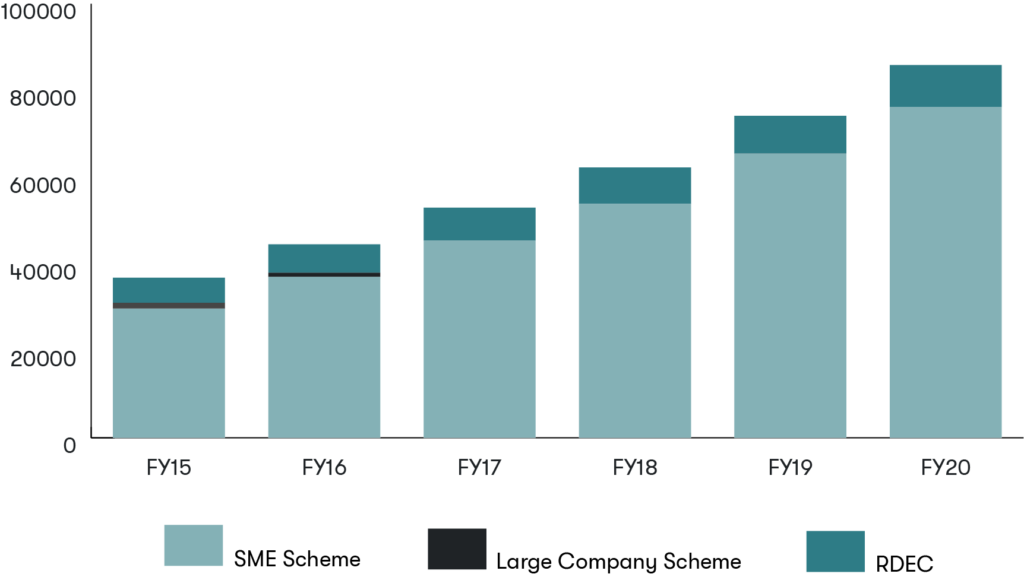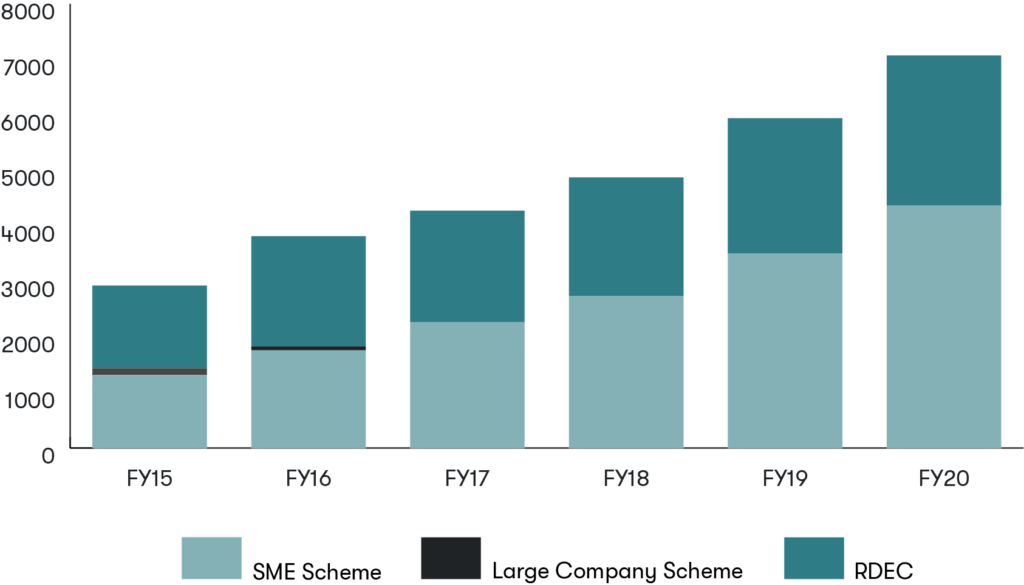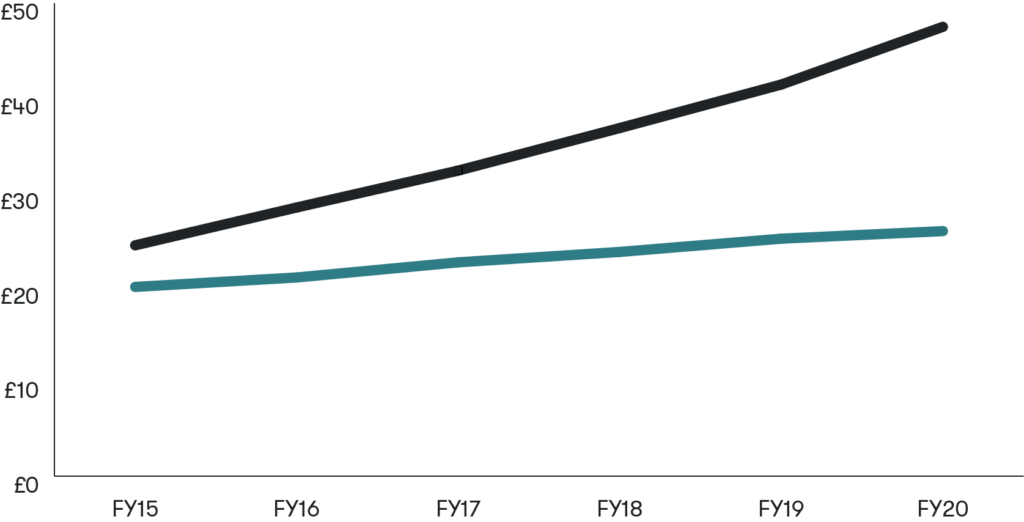
HMRC R&D TAX CREDITS REPORT
2021 Edition
R&D Tax Credits Report 2021: Key Takeaways and Trends
GrantTree delves into the key findings from the 2021 R&D Tax Relief report.
HMRC has just released its latest annual report on the R&D Tax Relief scheme, a generous, publicly-financed initiative that rewards companies for investing in development work.
Far from being a dry, government-mandated formality, the report is packed full of insights into the state of startup and scaleup funding in the United Kingdom and the overall health of the country’s innovation ecosystem.
This year’s offering – which examined claims between April 2019 and March 2020 – was particularly informative, providing rich statistical context to the impact of the pandemic and the stark regional disparities in development spending.
The report also restated the widening gap between the ONS estimation of domestic R&D investment and the amount of development spending used to claim R&D Tax Relief. This issue is a growing concern for the government and HMRC–one that risks jeopardising the integrity and accessibility of this vital source scheme.
Let’s take a deeper look at the report’s key findings and decipher what they have to tell us about innovation funding in the UK.
R&D Tax Relief claims rise 16%, driven by SMEs
There were 85,900 R&D Tax Relief claims in FY20, 16% more than the previous year and the most in the scheme’s history.
This increase was primarily driven by a rise in the number of claims for SME R&D Tax Relief – the arm of R&D Tax Relief aimed at micro, small and medium-sized businesses – which were also 16% higher than in FY19.

There are two main reasons for this surge in SME claims.
The first is the pandemic. National and regional lockdowns took a heavy toll on British businesses, and on smaller companies especially. McKinsey & Company found that 80% of UK SMEs saw revenues fall in 2020. To offset these losses, and weather the adverse economic conditions caused by the pandemic, an astonishing 84% of smaller firms took on some form of outside financing last year.
This funding was sourced from a combination of Covid-specific grants like the Coronavirus Job Retention Scheme, state-backed lending programmes like the Bounce Back Loans, and, judging by the figures in this report, R&D Tax Relief.
The second reason for the spike in SME claims – which have been rising steadily since 2014 – is growing awareness of the R&D Tax Relief scheme itself.
Over the years, the government and R&D Tax Credits consultancies like GrantTree have worked to educate businesses on their eligibility for R&D Tax Relief. Our team of tax and technical specialists have worked hard to publish a comprehensive and regularly updated library of blogs, eligibility quizzes and walkthroughs – plus the most comprehensive guide to claiming you’ll find online – that are all designed to help companies navigate this scheme.
Our work illuminating the R&D Tax Credits scheme for eligible companies makes the growth in SME claims particularly gratifying.
While it’s clear that not all claimants are truly eligible for funding – a point I’ll discuss in greater detail later – I do hope to see this upward trend continue, even as the effects of the pandemic subside.
Are you claiming your full R&D Tax Credits allowance?
Total support paid out increased 19%. SME support rose 25%
The total amount of support paid out by the R&D Tax Relief in FY20 exceeded £7.4 billion. This is 19% more than FY19 and an all-time high for the scheme.
The total support paid out by the SME R&D Tax Relief leapt 25% to £4.4 billion, another record. The average value of SME claims reached £57,000, a 7% increase over the previous year.

Truth be told, I have mixed feelings about this growth in average claims size.
On the one hand, it could signal that companies are making concerted efforts to claim every eligible penny from the R&D Tax Credits scheme. Clearly, this would be a good thing. Time and time again we encounter companies that have claimed less relief than they’re entitled to.
A rise in average claim size points to companies maximising their claim values. They will have done this either by dedicating more time to understanding the scheme and unearthing all eligible expenditure or by hiring a reliable R&D Tax Credits consultancy like GrantTree to do it in a fraction of the time.
On the other hand, it could also indicate that an increasing number of SMEs are incorrectly padding their claims with dubious expenses, most likely because they were advised to do so by one of the growing numbers of small, ‘rogue’ agencies branding themselves as experts in the field.
The latter possibility presents two problems.
The problem with inflated claims
First, at a macro level, it would mean the R&D Tax Credits scheme is delivering less value for money to the taxpayer.
We know the government is already concerned about this and is working with HMRC on ways to safeguard R&D Tax Relief against malicious filings and spurious claim sizes. But additional checks and restrictions could make the scheme slower and less accessible, which would be particularly damaging to eligible but time-poor businesses.
Second, at a micro level, it could spell trouble for the SMEs unwittingly engaged in this practice.
If HMRC thinks a company is attempting to claim R&D Tax Relief on ineligible costs, or believes the company’s development work fails to justify its claim size, the agency is likely to launch what’s called an HMRC R&D compliance check.
Compliance checks, also known as enquiries, are lengthy investigations that can delay a company’s R&D Tax Relief by months or even years. In addition to delays, enquiries are liable to damage a company’s relationship with HMRC while burying its finance and technical teams in time-consuming back and forths with the agency’s inspectors.
Defend Your Claim, Protect Your Funding
London retains its tax credits crown
Once again, London-based companies filed more claims and secured more relief than in any other region. Businesses headquartered in the nation’s capital accounted for 20% of filings and 31% of funding.
The South East excluding London was a distant second, accounting for 15% of claims and 18% of funding. It was followed by the East of England, which submitted 10% of claims and received 12% of relief, and the North West, which accounted for 10% and 7%, respectively.
On one level, these figures are hardly surprising. London has long been a hotbed for innovation, particularly in the software and financial services sectors. The capital continues to attract more talent and funding than any other part of the UK, so it was all but nailed on to receive the lion’s share of R&D Tax Relief.
But while London-based companies and investors may rejoice at spending yet another year at the top of the tax credits charts, these figures underscore the UK’s continuing struggles with regional inequality. And the difficulty much of England, Scotland, Wales and Northern Ireland face in holding on to promising people and ideas.
The government has made redistributing investment and brainpower away from London a crucial part of its domestic policy agenda, most notably through its much-trumpeted levelling-up initiative.
The government is also hoping to energise research and productivity across the UK with its R&D Place Strategy, unveiled as part of its R&D Roadmap, which broadly explains the government’s plan to cultivate a more science and technology-focused economy.
BERD is the word
Every year, the Office of National Statistics’ Business Enterprise Research and Development (BERD) survey tries to determine how much money UK businesses are spending on R&D.
While BERD and the R&D Tax Relief scheme measure ‘research and development’ differently – for example, BERD only counts work that takes place in the UK while the R&D Tax Relief data includes fees for offshore subcontractors – one would expect the amount of investment unearthed by the ONS survey would more or less mirror the amount of expenditure used to claim government funding.
But this is not the case. In fact, since around 2014, the amount of R&D picked up in BERD has been significantly lower than the amount of development investment used to claim R&D Tax Relief.
Whatsmore, the gap between the two figures is growing. In FY14, the expenditure used to claim R&D Tax Relief was 35% higher than the investment recorded by the BERD survey; in FY20, it was 83% higher.

Explaining the BERD gap
Only so much of this variance can be explained by the different ways the two systems track R&D. If that were the sole reason, we would expect to see the relationship between the figures for BERD and R&D Tax Relief staying relatively consistent.
The more probable and more worrying explanation, as I explained earlier, is that a growing number of SMEs are filing inflated and potentially ineligible R&D claims.
Again, this is not because smaller businesses have decided en masse to defraud the government. Nor is it the result of smaller firms discovering some easily exploitable flaw in the scheme’s administration.
Instead, the real culprit is rogue R&D Tax Credits consultancies, churning out oversized tax relief claims without comprehension or care for the scheme’s regulations. These small, risk-happy providers have spread like wildfire over the last few years, their reckless practices imperilling the accessibility of the scheme for the many thousands of companies who claim their true entitlement.
The government and HMRC are becoming increasingly concerned about this issue. And about the integrity of the R&D Tax Relief scheme more generally. This is why the government recently reintroduced the PAYE Cap, a policy designed to stop shell corporations funnelling tax credits overseas.
HMRC made sure to discuss spurious claims at recent meetings of the Research and Development Consultative Committees – a twice annual meeting between HMRC and tax advisors such as GrantTree.
The agency also explored whether it should regulate providers in a recent, wide-ranging consultation of the future of the R&D Tax Credits scheme.
All this suggests we may soon see HMRC policing R&D Tax Relief more tightly. Here’s hoping it can do this without limiting access to legitimate companies.